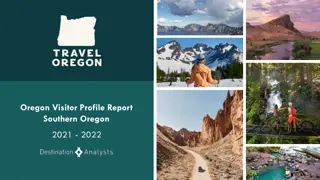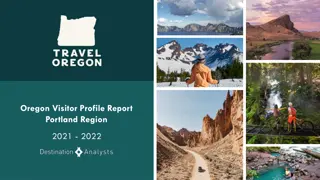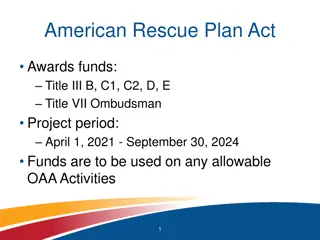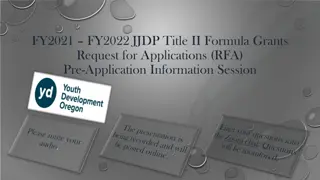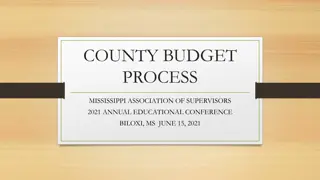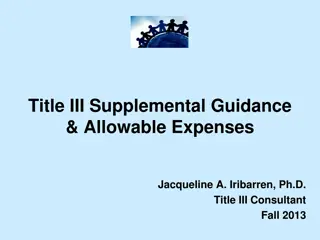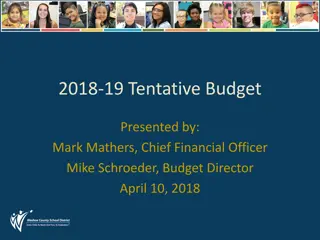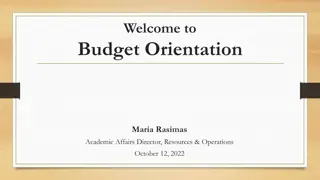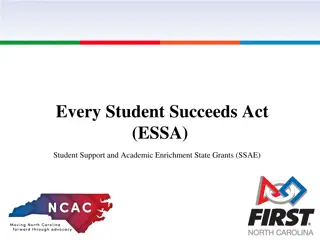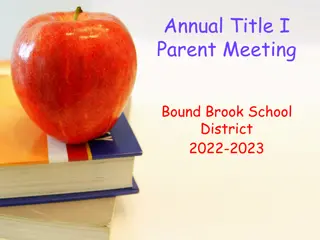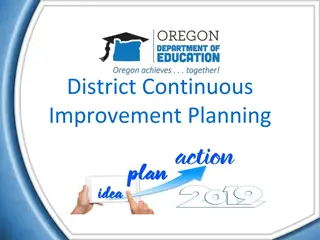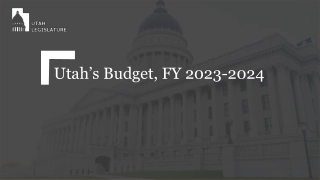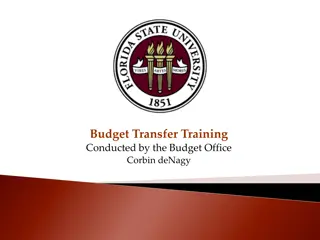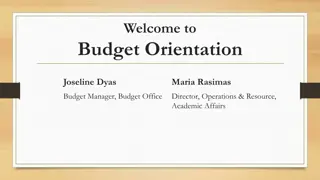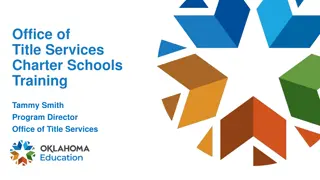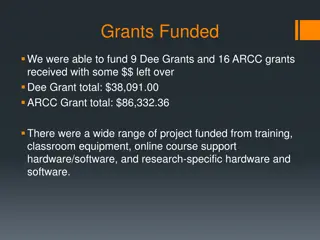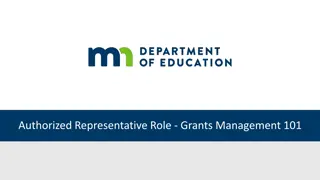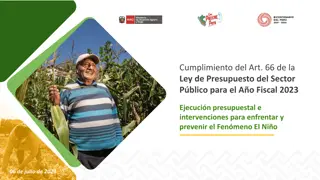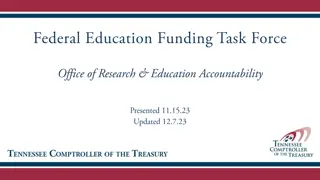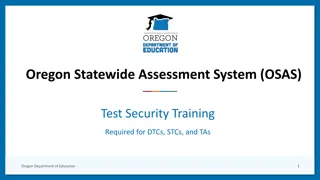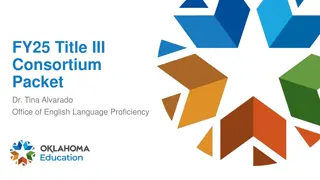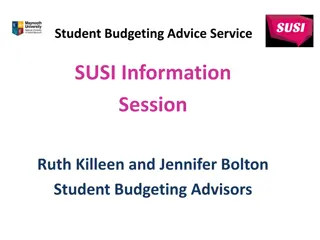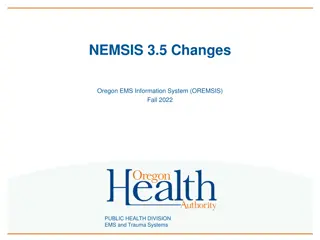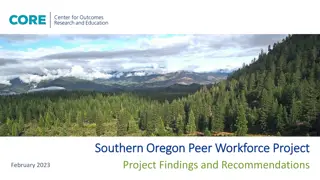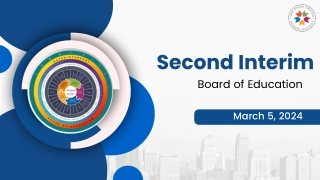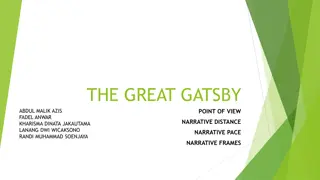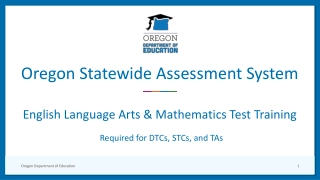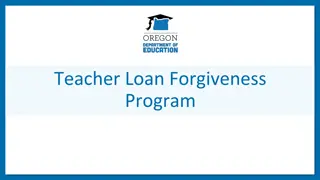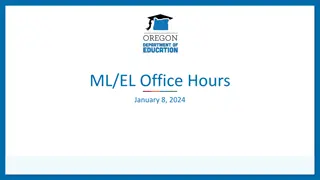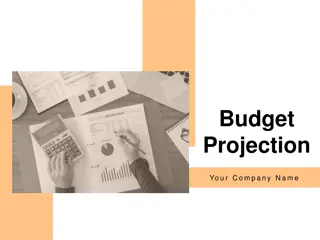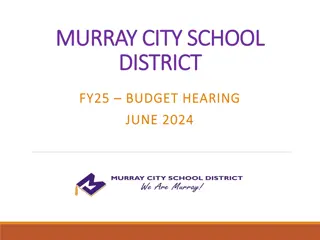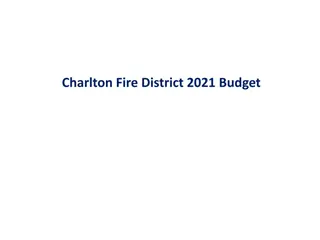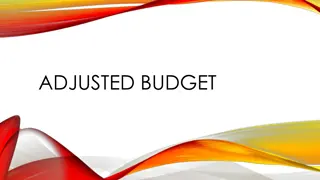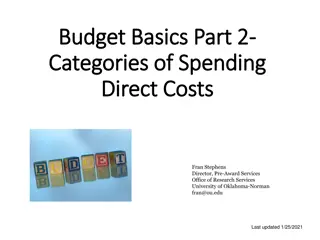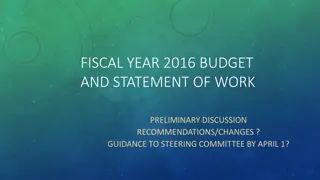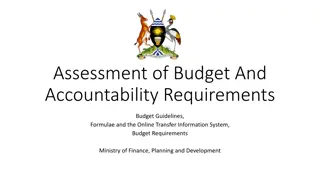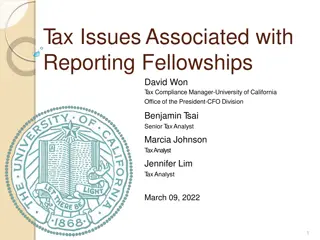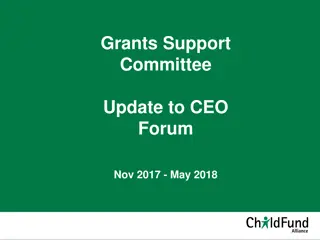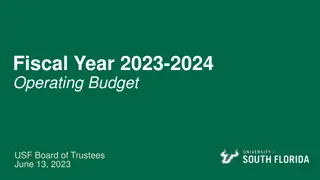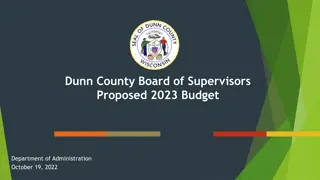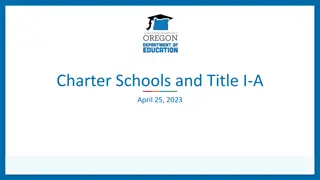Budget Narrative for Title III Grants in Oregon Education 2023-24
This budget narrative outlines the goals of Title III grants for the Oregon Department of Education, focusing on aiding English learners in attaining language proficiency and academic achievement. It emphasizes the importance of Supplement not Supplant regulations to ensure proper fund allocation and outlines five key objectives of Title III under ESEA. Additionally, it explains the three tests to prevent supplanting of funds and provides guidance on effective planning and submission of the budget narrative.
Download Presentation

Please find below an Image/Link to download the presentation.
The content on the website is provided AS IS for your information and personal use only. It may not be sold, licensed, or shared on other websites without obtaining consent from the author. Download presentation by click this link. If you encounter any issues during the download, it is possible that the publisher has removed the file from their server.
E N D
Presentation Transcript
Title III Budget Narrative 2023-24 Oregon Department of Education 1
Goals At the end of this training, participants will be able to: Understand how Supplement not Supplant applies to Title III grants; Be able to plan for the Budget Narrative submission; Understand the timelines for the Title III grants to be used; Know how to pull the data necessary for the detailed narrative section; Understand the reconciliation expectations for the Title III budget.
Purpose of Title III There are five purposes of Title III under the ESEA: 1. To help ensure that English learners (ELs), including immigrant children and youth, attain English language proficiency (ELP) and develop high levels of academic achievement in English; 2. To assist all ELs, including immigrant children and youth, to achieve at high levels in academic subjects so that all ELs can meet the same challenging State academic standards that all children are expected to meet; 3. To assist teachers (including preschool teachers), principals and other school leaders, State educational agencies (SEAs), local educational agencies (LEAs), and schools in establishing, implementing, and sustaining effective language instruction educational programs designed to assist in teaching ELs, including immigrant children and youth; 4. To assist teachers (including preschool teachers), principals and other school leaders, State educational agencies (SEAs), and local educational agencies (LEAs) to develop and enhance their capacity to provide effective instructional programs designed to prepare ELs, including immigrant children and youth, to enter all-English instructional settings; and 5. To promote parental, family, and community participation in language instruction educational programs for the parents, families, and communities of ELs. (ESEA 3102)
Supplement not Supplant ESSA language for Supplement not Supplant is different than NCLB for Title I-A, but not different for Title III and Title I-C. Carefully think through proposed activities to ensure that they do not supplant any local, state, or other federal requirements, or that the activity was not funded under any local/state/federal funds the prior school year. Consider how your proposed activities meet the purposes for Title III. Review the three question test of supplanting.
Supplement Not Supplant 3 Tests Federal funds cannot be used to supplant, or take the place of, funds that would have been spent if Title III funds were not available. Test I: Are the services that the district wants to fund with ESEA funds required under state, local, or another federal law? If they are, then it is supplanting and not allocable with Title III funds. Test II: Were state or local funds used in the past to pay for these services? If they were, it is supplanting and not allocable with Title III funds. Test III: Are the same services being provided in other schools paid for with state or local funds? If they are, then it is supplanting and not allocable with Title III funds.
Direct Administrative and Indirect Rates Title III is unique with regard to Direct and Indirect Administrative Rates that is different from Title I-A. Title III can use the negotiated Indirect Rate, and Title III can have maximum indirect of 2% in ESSA; HOWEVER, The total amount claimed for both Indirect and Direct Admin cannot exceed the Negotiated Indirect Rate. Example: A sub-grantee has a negotiated indirect rate of 5.6%, the sub-grantee wants to claim the 2% allowable Title III Indirect; therefore, the sub-grantee is allowed to claim a maximum of 3.6% for Indirect. Direct and Indirect Admin percentages are coded on the Consolidated Spending page for Budget Narrative. For sub-grantees with private schools participating in Title IIII the sub-grantee may apply the 2% Title III Indirect amount off the per student allocation when calculating private school equitable share.
Timelines and Updates 2023-24
Important Timelines August: CIP Budget Narrative application opens for Title III Regular School Year October 1: Prerequisites Due i.e., private schools, consolidated spending, and contacts November 1: Title III Regular School Year (RSY) Budget Narrative Due Mid-November: CIP Budget Narrative Title III Carryover opens Early January: CIP Budget Narrative Title III Immigrant opens Grant recipients will need to update the contacts page January 30: Title III Immigrant CIP Budget Narrative Application Due January 30: Title III Carryover CIP Budget Narrative Application Due February 1: Any Title III RSY Budget Narrative not submitted will have a hold in EGMS April 1: Any Title III Immigrant Budget Narratives not submitted will have a hold in EGMS June 3: All Title III grants without an approved Budget Narrative will be liquidated
Funding Timelines Due to COVID-19 impacting sub-grantees availability to use the 2021-22 carryover funds, Title III received a Tydings Waiver from the US Dept of Education, and these funds are available for use until September 30, 2024. Districts needing to revise how these funds will be spent must email Kim Miller this completed Carryover Revision Request form Please note: Supplement not supplant rules apply to revisions, Include as much detail as possible, and Until the sub-grantee receives approval from ODE staff the activities on this form are not approved for use.
JULY AUG 2023 NOV 2023 2023 BEGINNING OF 2022-23 GRANT PERIOD 2023-24 BUDGET NARRATIVES DUE 2022-23 BUDGET NARRATIVE APPLICATION OPENS 2023-24 FEDERAL FUNDS TIMELINE JUNE 2024 NOV 2024 SEPT 2024 FINAL DATE FOR ALL 2023-24 CLAIMS FOR *INITIAL GRANT PERIOD FINAL DATE FOR OBLIGATION OF 20223-24FUNDS FOR *INTIAL GRANT PERIOD NOV 2024 UNCLAIMED FUNDS BECOME CARRYOVER NOV 2024 NOV 2025 SEPT 2025 CARRYOVER APPLICATIONS FOR 20223-24 FUNDS OPEN FINAL DATE FOR OBLIGATION OF 2023-24 FUNDS FINAL DATE FOR ALL 2023-24 GRANT CLAIMS *INITIAL GRANT PERIOD: 7/1/23-9/30/24 (15 MONTHS) Oregon Department of Education
Annual Budget Narrative and Fiscal Timeline Signed Assurances and Prayer Certificate due CIP Budget Narrative opens CIP Budget Narratives due Claim funds in EGMS Quarterly June 30 August November 1 July October 1 January Final allocations posted Carryover CIP Budget Narratives due Prerequisites due Contacts Private Schools Consolidated Spending Oregon Department of Education 11
Title III Grant Use Chart Grant Name Dissemination year Spend funds by date: Claim funds by date: Notes Title III RSY 2021-22 9/30/24 11/2024 T-III Tydings waiver approved June 2023 Title III Immigrant 2021-22 9/30/24 11/2024 T-III Tydings waiver approved June 2023 Title III RSY 2022-23 9/30/24 11/2024 Normal timeline including carryover Title III Immigrant 2022-23 9/30/24 11/2024 Normal timeline including carryover Title III RSY 2023-24 9/30/25 11/2025 Normal timeline including carryover Title III Immigrant 2023-24 9/30/25 11/2025 Normal timeline including carryover RSY = Regular School Year Oregon Department of Education 12
ESSA FEDERAL PROGRAMS included in the CIP Budget Narrative Title I, Part A (Improving Basic Programs) Title I, Part C (Migrant Education) Title I, Part D (Neglected and Delinquent) Title II, Part A (Supporting Effective Instruction) Title III, Part A (English Learner and Immigrant Youth) Title IV, Part A (Student Support & Academic Enrichment) Title V (REAP and RLIS)
Heres How to Access Your CIP Budget Narrative Here are the steps to access CIP Budget Narrative Application. 1. Make sure your district security administrator has granted permission to read, write, edit, and submit this ODE application. 2. Sign in to your ODE District secure applications on the ODE district secure web page - central log in. 3. Select the CIP Budget Narrative Application from your application list.
BUDGET NARRATIVE OVERVIEW Click on the Section on the Overview page to open the specific Federal Title Budget Narrative page. Oregon Department of Education 16
Title III RSY Components Overview Detailed Narrative Specific programmatic questions that explain: fund usage, required data, required collaboration Budget Narrative Specific activity funding page (includes function/object codes) Spending page A spreadsheet that is organized by function and object code based on the codes inserted on the Budget Narrative page (this is prepopulated for sub-grantees)
Budget Narrative - Requirements There are a few prerequisites that each district must complete prior to the Title III application being able to be submitted. For Title III Consortia, each member district must have these prerequisites completed.
Detailed Narrative Section 1 Section 1 In this section, the sub-grantee affirms the EL instructional program and EL instructional materials are the same as are explained in the district s approved submitted EL Plan. If the instruction for teaching English to identified ELs has changed for the 2023-24 school year, please provide an update in Section 1 Question 1 of the detailed narrative. If the instructional materials for the EL program have changed, please provide an update in Section 1 Question 2. If there are no changes to the instructional program or materials, a statement to that fact will suffice for a response to these questions.
Detailed Narrative Section 2 Section 2 In this section the sub-grantees explain how they will use the supplemental Title III funds to enhance their EL program. There are three activities required to be funded by Title III; please see ESSA Section 3115(c) for all the Title III activities. Describe how the district will use the supplemental Title III funds to enhance or expand the district s EL program for English language acquisition. Include the description of how the district will measure the effectiveness of these activities. Describe how the sub-grantee will use the supplemental Title III funds to enhance or expand the support ELs access to core content (ELA, Math, and Science). Describe how the sub-grantee will use the supplemental Title III funds for district outreach for parents, families, and communities.
Connection to Budget Section Section 2 The activities included in section 2 of the Detailed Narrative must align with the activities in the required activities in the Budget Narrative section. Sub-grantees will be asked to revise the appropriate sections if these two areas are not aligned. Sub-grantees do not need to explain the core EL instructional program in their Section 2 responses, only the supplemental activities that will be funded with Title III are included. Oregon Department of Education 22
Detailed Narrative Section 3 Section 3 In this section the sub-grantee provides data required by ESSA Title III on the academic and linguistic outcomes of their English learners. Number and percentage of ELs and ELs with IEPs identified 5 or more years who did not obtain proficiency. Number and percentage of ELs with IEPs obtaining proficiency for all ELs with IEPS and those identified 5 or more years. Number or percentage of monitored and former ELs meeting/exceeding state content assessments. 4-year and 5-year graduation cohort rate for students identified as ELs anytime in high school and same 4-year and 5-year rates for all students.
Help for Section 3 Data Districts should review the following items for the necessary data for Section 3 Achievement Data Insight ODE secure application On track to ELP (OTELP) includes Information on ELs and ELs with IEPs Making progress on English proficiency Obtaining English proficiency Number of years identified as an EL ELA/Math/Science achievement data Includes the students meeting/exceeding state academic expectations District may need to determine which students in the Ever EL group are in monitor or former EL status Report card (or ADI) 4-year and 5-year graduation rate for students anytime as EL in HS Oregon Department of Education 24
Consultation/Coordination Questions Sub-grantees are required to consult/coordinate with: Parents, guardians, community members regarding the use of the Title III funds Include a description on this consultation process Private schools participating in Title III funds Include the consultation process Discussion of funds to be used to Identify students as ELs Annually assess student English proficiency Equitable share A note for "no participating private schools" will suffice for the private school section. Oregon Department of Education 25
Budget Narrative Tab Oregon Department of Education 26
Budget Narrative Guidance Guidance to assist sub-grantees with submitting the budget section of the Budget Narrative section in the CIP Budget Narrative application. Include the number of staff (including staff position) in all professional development activities funded by Title III. Include the Title III percentage for activities co-funded with other funding sources. Include number of participants in all family, parent, community activities to ensure the requested amount is reasonable. Include the number of students, teachers, etc., for any extended day/year activity. These details provide ODE staff with the needed information to determine the reasonable and necessary use for the expenditure. Sub-grantee not including this information will be asked to revise their Budget Narrative application. Optional allowable activities, are allowable after the sub-grantee has included funding for the three required activities.
Budget Narrative Tab Coding/Fiscal Expenses The first three activities listed (next slide) are required Title III activities. Sub-grantees must include Title III funding for each of these activities. This could mean leveraging Title III funds to support work already in progress under other funding streams. If these activities are joint-funded or funded with other grants the sub-grantee has available, please include that information briefly (the sub-grantee will be required to put a minimum of $1.00 for each activity). US Education Title III Guidance is located here; the three required Title III activities are included on the following slide.
Required Title III Funded Activities 1. List supplemental activities to support the English language development for ELs (this includes PD). 2. List supplemental activities to support ELs access to core content (ELA, Math, and Science) (this includes PD). 3. List supplemental activities for district outreach for parents, families, and communities. For Title III Consortia, all of the three above required activities must be funded, but not all member districts need to participate in all three activities.
Private Schools Sub-grantees having private schools participating in Title III must include the consulted activities in the budget section of the CIP Budget Narrative application. There is a specific function/index code for private schools. ODE staff will review the information in the detailed narrative section to ensure activities align with proposed expenditures in the budget section. List activities for local private schools participating in Title III; make sure to include funding for all private schools accordingly. ODE staff review your district grant intent submitted in June and the private school tab in Budget Narrative to ensure all private schools participating in Title III are included in the budget.
What Happens if ODE Returns my Budget Narrative Submission? You are not alone if ODE staff have to return your budget narrative for additional information. Most times there is a misunderstanding of language used. ODE staff include comments in the public comment section to assist you in your resubmission. Please read over all comments from all tabs (Detailed Narrative, Budget Narrative, and Spending Page). Double check which sections have a Red square for Response Required, and make sure to address the requested requirements for all sections prior to resubmitting. If you have questions about a returned Budget Narrative, please contact Kim Miller
Reconciling CIP Budget Narratives & Spending
Reconciliation Basics What: Ensuring actual spending aligns to narrative Why: Demonstrate that each award is used as intended Identify transaction errors Ensure that award expenditures are complete Plan for remaining funds as carryover When: At least quarterly Anytime a new activity is added If a change to an approved activity is 10% or more Oregon Department of Education
Current year narratives Hit REVISE in CIP Budget Narrative dashboard Resubmit for review What if our plan changes? Approved Carryover Narratives Complete the Carryover Revision Request form Fiscal returns to ODE Reimbursement SmartSheet Oregon Department of Education 34
Key Takeaways It is OK if plans change Expenditures must match approved plans Reconcile at least quarterly Oregon Department of Education 35
Oregon Federal Funds Guide Resources ODE Federal Quick Reference Briefs CIP Budget Narrative User Guide Federal Funds Timeline Carryover Revision Request Form Reimbursement form Oregon Department of Education 36
Questions ODE staff are here to support you with your federal grants; please feel free to ask questions now or contact them for personal support. Oregon Department of Education 37
Contact and Resources Kim Miller Title III Education Specialist Kim.a.miller@ode.Oregon.gov 971-239-9681 Leslie Casebeer Title III Office Specialist Leslie.casebeer@ode.Oregon.gov Title III Funding and Grant web page Federal Funding web page Oregon Department of Education 38


